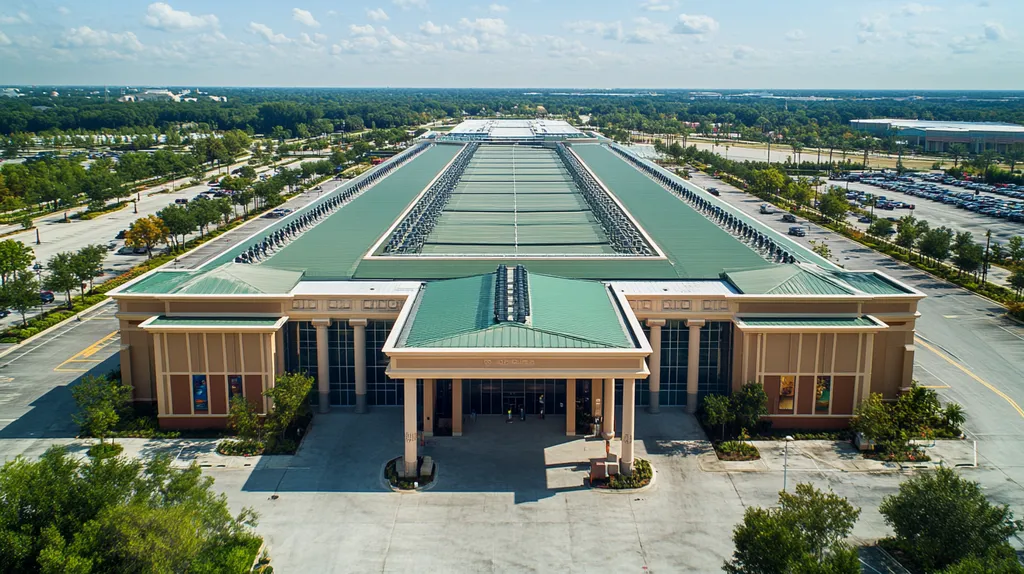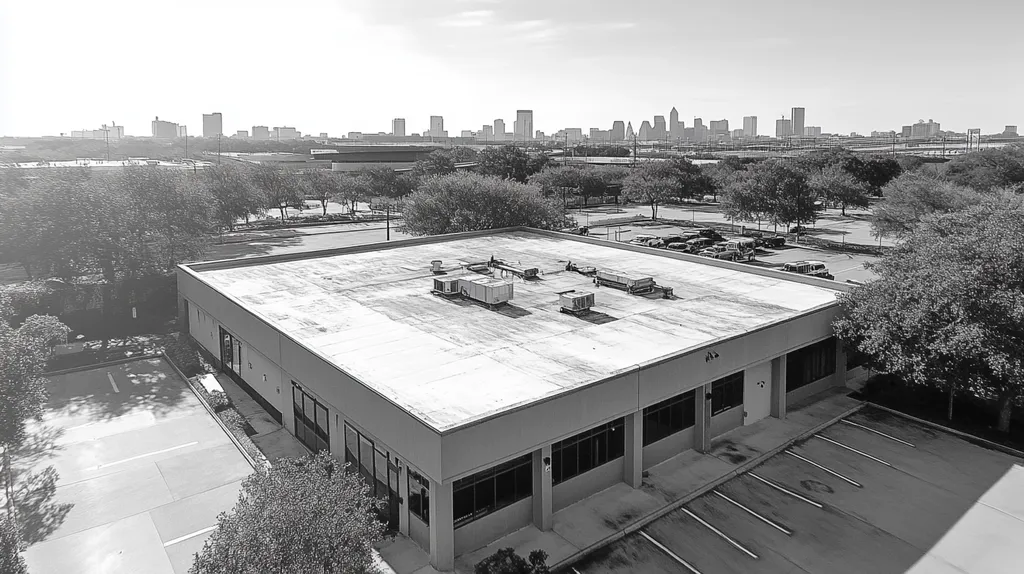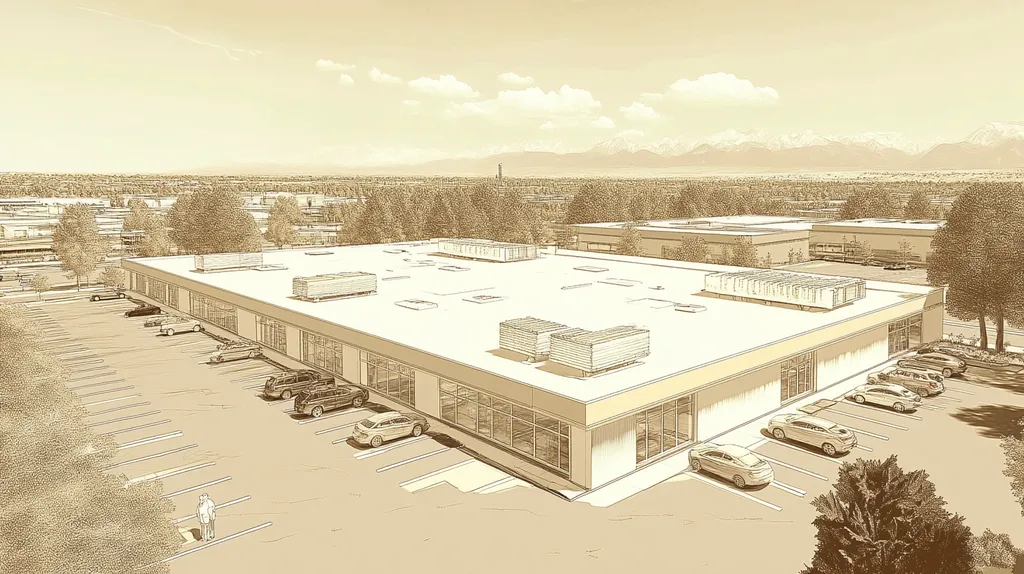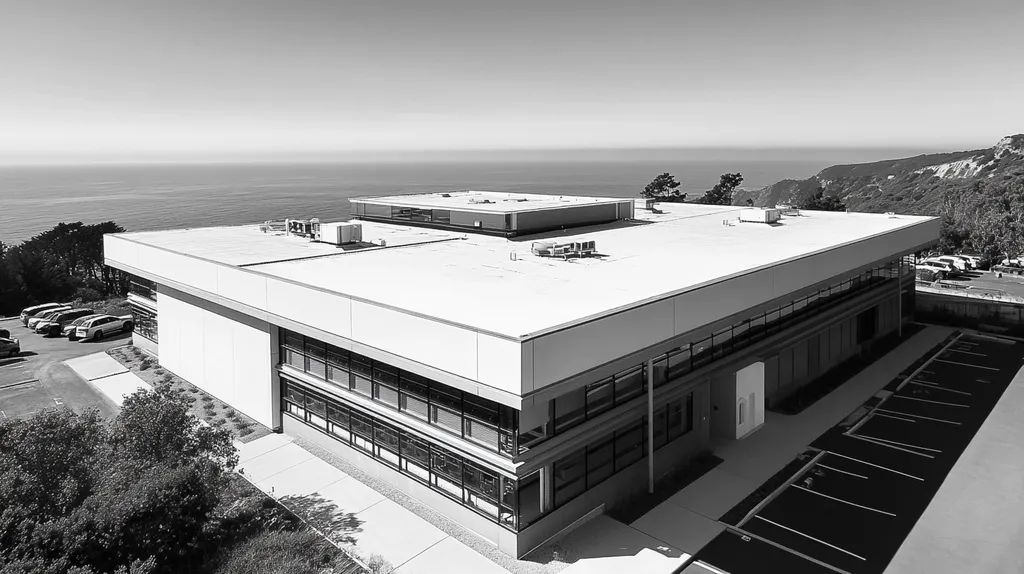In the evolving landscape of commercial roofing, nearly 40% of roof failures stem directly from inadequate coating formulations, resulting in billions in annual repair costs across North America.
While the industry has made remarkable strides since the days of simple tar applications, the surge of new coating technologies has created a complex web of standards that many property owners struggle to navigate.
This comprehensive analysis examines the critical distinction between industry-compliant formulations and subpar alternatives, offering property managers clear guidance for protecting their investments through evidence-based coating selection.
SECTION 1: COMMON MISCONCEPTIONS
The commercial roofing landscape is fraught with challenges, often stemming from common misconceptions about roof coating formulations. These misunderstandings can lead to ill-informed choices, resulting in significant financial repercussions for property owners and facility managers. For example, misinterpretation of ASTM standards might lead to the selection of inferior materials that jeopardize the roof’s integrity. Additionally, overlooking regional climate factors can cause early coating deterioration. This section will delve into the crucial myths surrounding ASTM standards, the impact of regional climate variations, and the diverse nature of roofing coatings.
Misunderstanding ASTM Standards
A prevalent misconception within commercial roofing revolves around the understanding of ASTM standards. These standards offer vital guidelines for testing the performance of roof coatings, yet many property owners mistakenly believe that any product meeting these benchmarks will automatically suit their needs.
This assumption can be misleading. A coating may successfully pass an ASTM adhesion test but might falter under local weather conditions. Without thorough evaluation, a property manager could select a product that thrives in one climate but fails miserably in another.
Moreover, many manufacturers report compliance with ASTM standards, but this often lacks transparency. Such ambiguity can lead to misplaced confidence in a product’s durability. Property managers need to investigate further, grasping the relevant tests and their importance to their unique circumstances.
Understanding ASTM standards empowers stakeholders to make informed choices, ensuring that selected coatings address the specific demands of each building’s environment (source: ASTM).
Ignoring Regional Climate Variations
Another significant misconception is underestimating the role of regional climate variations on roof coatings. Many facility managers assume that a coating performing well in one climate will equally succeed in another. However, climate fundamentally influences the longevity of roof coatings.
For instance, a product designed for a hot, dry climate may struggle in humid coastal areas, where moisture could trigger algae growth or lead to delamination. Disregarding these regional differences frequently results in unexpected, costly roof replacements.
Moreover, certain coatings may lack sufficient UV reflection, causing overheating and escalating energy costs. Recognizing local climate characteristics—like temperature fluctuations and precipitation trends—helps property owners choose suitable products.
In essence, acknowledging regional climate variations is vital for ensuring effective coating performance, protecting investments, and extending the lifespan of commercial roofs.
Assuming All Coatings Are Equal
Lastly, there is a widespread belief that all roof coatings are created equal in terms of protection and performance. This assumption can severely skew roofing decisions. In reality, coatings vary significantly in composition, durability, and their compatibility with different applications.
For example, certain coatings are more flexible and better suited for structures that experience movement, while others may be rigid and prone to failure over time. Furthermore, some coatings have superior resistance to chemicals and pollutants, making them more fitting for industrial environments.
Property owners often overlook critical details, mistakenly thinking that a lower price guarantees comparable quality. This oversight may lead to choosing lower-quality products that demand frequent maintenance or replacement, ultimately increasing overall costs.
Education plays a crucial role; property managers should judge coatings based on performance data and real-world evidence instead of mere marketing claims. By understanding the differences between products, they can make informed decisions that genuinely meet their specific needs.
SECTION 2: PRACTICAL IMPLICATIONS
The choice of roof coating formulations is a decisive factor in the longevity and performance of commercial roofing systems. Selecting inferior products can lead to disastrous outcomes, including soaring repair costs and roofs that fail far too soon. For instance, while high-quality coatings can protect a roof for over a decade, substandard materials may exhibit noticeable damage in just two years. It is imperative for property owners and facility managers to recognize how these formulation standards can impact the overall effectiveness of roofing systems.
Impact on Roof Durability
The durability of a commercial roof largely hinges on the coating that is applied. Coatings of inferior quality can suffer from issues such as cracking, peeling, and fading, which drastically shorten the lifespan of the roof. For example, a roof treated with a premium elastomeric coating can endure severe weather conditions, whereas a cheaper alternative may succumb to such challenges, resulting in extensive damage.
Additionally, coatings that fail to meet industry standards often lack the flexibility necessary to withstand thermal expansion and contraction. A quality coating reliably maintains its bond with the substrate, supporting roof longevity. In contrast, those that do not adhere to these standards are more likely to experience premature failure.
Property owners should also evaluate the warranty associated with the coating. Reputable manufacturers offer longer warranties for certified products, reflecting their confidence in the coating’s durability and long-term effectiveness. This assurance can translate into significant peace of mind for facility managers.
In essence, selecting a coating that aligns with established industry standards is a strategic investment, reducing the chances of early failure and unnecessary repair expenses.
Effects on Energy Efficiency
The type of roof coating utilized can greatly affect a building’s energy efficiency, especially in urban settings where heat retention can be problematic. High-quality reflective coatings can lower rooftop temperatures by as much as 50 degrees Fahrenheit, resulting in decreased cooling expenses. It has been shown that buildings equipped with effective reflective coatings can experience energy savings of up to 30% during peak summer months.
Coatings that meet or exceed established industry standards are engineered to maximize reflectivity and emissivity, optimizing a building’s energy performance. In contrast, subpar formulations may fail to deliver these critical benefits, leading to increased energy consumption and operational costs.
Moreover, energy-efficient coatings play a pivotal role in sustainability, reflecting heat back into the atmosphere rather than allowing it to be absorbed. This is increasingly vital in addressing urban heat island effects and supporting community-wide initiatives focused on environmental responsibility.
As energy prices continue to climb, investing in an effective coating solution can yield substantial savings over time, reinforcing the notion of it being a wise investment for commercial property owners.
Maintenance and Repair Challenges
The selected roof coating has a direct influence on maintenance and repair demands for building operators. Coatings that fall short of industry standards are often associated with a host of issues, including mold growth and moisture retention. Such complications can result in expensive maintenance and repairs, detracting from funds that could be applied elsewhere.
Additionally, some non-compliant coatings may necessitate more frequent inspections and touch-ups, adding to the workload of facility managers. On the other hand, premium coatings usually require less vigilant maintenance and are easier to repair if issues arise.
Understanding the maintenance implications of coating choices is vital for property owners. By selecting a well-regarded coating, they can simplify upkeep and mitigate potential problems for the future.
Ultimately, investing in durable, industry-compliant roof coatings not only streamlines maintenance efforts but also allows facility managers to concentrate on their core responsibilities, rather than constantly addressing roofing concerns.
SECTION 3: COST OF MISINFORMATION
The consequences of misinformation regarding roof coating formulations can be both dire and costly. When property owners are misled about compliance with industry standards, they may inadvertently invite financial turmoil. Research indicates that businesses utilizing non-compliant materials can incur repair costs that are 30% higher compared to those making informed choices. It’s essential for property owners and facility managers to grasp the financial, operational, and legal implications associated with this misinformation to safeguard their investments.
Financial Consequences of Non-Compliance
Opting for the wrong roof coating due to misinformation has the potential to wreak havoc on a property’s finances. Coatings that fail to meet industry standards are notorious for leading to premature failures. A 2022 report highlighted that facilities employing inferior coatings faced unexpected repair costs reaching upwards of $50,000.
These financial burdens don’t solely stem from repair expenses; non-compliance can also void valuable warranties, making future replacements even more costly. By making decisions backed by accurate information, property owners can better protect themselves from these financial pitfalls.
Although cheaper, non-compliant coatings may seem like a bargain initially, the long-term expenses linked to repairs and replacements can quickly outweigh any short-term savings. This necessitates careful consideration of immediate costs versus long-term financial health. Investing in high-quality materials today can spare property owners the expenses of premature replacements tomorrow.
Moreover, the consequences of non-compliance can impact the building’s resale value. A roof system that meets industry standards typically attracts higher offers, while properties with questionable coatings may face price reductions.
Increased Maintenance and Replacement Costs
When roofing materials fail to adhere to industry standards, maintenance can transform into a continuous financial drain. Poorly formulated coatings often lead to increased repair needs, causing disruptions in normal business operations. For example, a factory experiencing an unanticipated roof failure could face costly downtime, resulting in lost revenue.
The cumulative impact of these maintenance issues can destabilize budgets that could have been allocated to critical business priorities. Over time, the expenses associated with inspections and repairs could escalate, potentially doubling or tripling compared to compliant alternatives.
Additionally, inadequate coatings can worsen weather-related challenges, such as leaks or insulation failures, ultimately leading to higher energy costs. Coatings that meet industry standards help improve energy efficiency, and losing that benefit can further strain operational budgets.
Therefore, while opting for non-compliant roofing materials might save money upfront, it often results in a cycle of ongoing financial loss due to increasing maintenance costs. A proactive approach focused on industry-standard coatings can shield property owners from these hidden expenditures.
Potential Liability and Insurance Issues
The ramifications of misinformation can extend well beyond financial concerns, as they can open the door to potential legal liabilities. In the event of a roof failure due to non-compliance, property owners may find themselves facing lawsuits or claims from tenants and stakeholders. Furthermore, without documented compliance, insurance claims may be denied, compounding the financial strain.
Insurance companies often require verification that roofs conform to industry standards before issuing policies. A non-compliant roof may not only lead to claim denials but can also create hurdles when attempting to secure coverage in the future. This precarious situation could leave property owners vulnerable to severe losses.
Liability issues can escalate if damage occurs to adjacent properties due to roof failures. Legal fees and settlements in these scenarios can far surpass the costs associated with investing in compliant materials from the outset.
Therefore, the risk of increased insurance premiums and potential liabilities should encourage property owners to prioritize accurate information. Gaining a solid understanding of roof coating standards nurtures informed decisions that minimize risk and protect investments.
SECTION 4: REALITY CHECK
The stakes for commercial roof coatings have never been more critical. With an alarming 50% of roof failures attributed to inadequate coatings, property owners face mounting risks to their investments. As technologies evolve and standards shift, understanding these developments is essential for making informed decisions. This section explores the advancements in roof coating technology, the latest industry standards, and best practices that should be adopted for optimal results.
Evolution of Roof Coating Technology
The evolution of roof coating technology has revolutionized the commercial roofing industry. Early coatings centered on basic waterproofing and adhesion, but advancements have transformed today’s options to emphasize energy efficiency and sustainability.
Modern formulations utilize state-of-the-art polymers and reflective pigments, significantly enhancing durability while contributing to energy savings. This shift not only increases the lifespan of roofs but also aligns with eco-friendly practices that are now expected in building projects.
Property owners must keep abreast of these technological advancements. Innovative solutions are more effective and environmentally conscious, offering significant advantages over their predecessors.
Selecting a coating based on recent technological developments helps mitigate risks associated with potential premature roof failures. Staying informed enables property managers to protect their assets and enhance overall building performance.
Updated Standards and Specifications
As coatings become increasingly sophisticated, updated standards and specifications are critical. Organizations like ASTM International and the Cool Roof Rating Council continually revise their guidelines to reflect modern performance and safety expectations.
These new standards emphasize essential attributes such as adhesion, flexibility, and weather resistance. By adhering to updated specifications, property owners can ensure their selected coatings perform reliably across various conditions.
Failure to comply with current standards can expose property owners to significant liabilities. Inferior coatings may deteriorate quickly and could also void warranties, resulting in costly repairs and replacements.
By remaining informed about these revisions, property owners and facility managers can make compliant choices that safeguard their investments and extend the life of their roofs, ultimately enhancing the building’s value. (source: ASTM)
Industry Best Practices and Guidelines
Implementing industry best practices is crucial for effective application and maintenance of roof coatings. Essential steps include proper surface preparation, consistent application methods, and establishing routine inspection schedules to ensure high performance.
Surface preparation, which may involve cleaning, priming, and repairs, is vital for promoting strong adhesion. Neglecting this foundational step can significantly compromise longevity.
Additionally, adherence to manufacturer guidelines regarding film thickness and curing times plays a crucial role in a coating’s effectiveness. Property owners should ensure their contractors are well-trained in the latest application techniques.
Regular maintenance and inspections can help identify early signs of wear or damage, allowing for prompt interventions. These proactive measures are key in reducing overall roofing costs over time.
SECTION 5: EVIDENCE-BASED ALTERNATIVES
The landscape of commercial roofing is rapidly evolving, driven by unpredictable weather patterns and stringent regulatory requirements. Property owners and facility managers must now embrace innovative standards for roof coatings that prioritize both durability and performance. Understanding these evidence-based alternatives is not just a matter of compliance; it’s essential for achieving lasting cost savings and enhancing overall building efficiency.
New Standards for Low Temperature Flexibility
One of the most crucial advancements in roof coating formulations is the establishment of new standards for low temperature flexibility. With many regions facing harsher cold weather, these standards have become vital for ensuring the longevity of roofing systems.
Low temperature flexibility enables coatings to expand and contract without cracking, preserving their protective qualities during significant temperature fluctuations. This characteristic is particularly essential for areas that experience frost and ice, where roofs without adequate flexibility risk leaks and water intrusion, leading to expensive repairs.
Coatings that meet or exceed these low temperature standards significantly enhance protection against moisture damage. As regulations evolve, property managers should stay informed about these requirements to make strategic decisions that safeguard their investments and minimize long-term maintenance costs.
Benefits of Type-I and Type-II Coatings
Property owners can choose between Type-I and Type-II coatings, each catering to different performance requirements. Type-I coatings are generally suited for less demanding environments, providing basic durability and ease of application.
In contrast, Type-II coatings offer enhanced performance features such as superior UV resistance and improved elasticity, making them ideal for regions with challenging weather conditions. By selecting Type-II coatings, property owners can invest in solutions that excel under extreme conditions and deliver greater long-term value.
Moreover, the use of high-quality materials in Type-II formulations often translates to longer product lifespans, which can offset initial expenses through reduced maintenance and repair needs. Understanding the environmental demands of a facility can help owners make well-informed choices between these two types of coatings.
Innovative Coating Materials and Formulations
The introduction of innovative coating materials is reshaping the commercial roofing market. New formulations, including those that harness nanotechnology or bio-based materials, aim to overcome the limitations of traditional products.
Coatings enhanced with nanotechnology provide superior adhesion, self-cleaning capabilities, and improved energy efficiency. These advancements not only boost overall performance but also contribute to sustainability goals within the roofing industry.
Bio-based coatings, derived from renewable resources, serve as eco-friendly alternatives that help lower the carbon footprint associated with roofing projects. As the industry shifts towards greener practices, these innovative materials are becoming increasingly relevant for mindful property owners.
By staying updated on these advancements, property owners can leverage innovative formulations to enhance efficiency and durability while aligning with contemporary environmental standards.
SECTION 6: TEST AND VERIFY
In the intricate realm of commercial roofing, the stakes are high. A subpar roof coating can lead to severe damage and jeopardize the safety of a property, resulting in long-lasting financial repercussions. Alarmingly, nearly 40% of commercial roof failures are linked to untested or inferior coatings. This section delves into essential certifications and testing protocols that can protect investments while extending the life of roofing systems.
Role of FM Global and UL Certifications
FM Global and Underwriters Laboratories (UL) certifications are crucial for ensuring product safety and performance. FM Global conducts rigorous testing to assess fire resistance and wind uplift, providing essential benchmarks that help property owners minimize their risk exposure.
UL evaluates the chemical properties and weather resistance of coatings, ensuring their effectiveness and long-term safety. By investing in UL-certified materials, property owners are more likely to choose products that endure environmental stresses over time.
Utilizing coatings with these certifications reduces the likelihood of premature roof failures and costly repairs. Moreover, certified products typically come with robust warranties, offering an added layer of assurance for property owners.
ICC-ES and CRRC Compliance
The International Code Council Evaluation Service (ICC-ES) performs evaluations that confirm a product’s compliance with established building codes. This includes thorough assessments of roof coatings that must adhere to specific industry standards, giving property owners confidence in the quality and safety of their chosen materials.
Additionally, the Cool Roof Rating Council (CRRC) measures the reflectivity and emissivity of roofing materials. High CRRC ratings signify excellent sunlight reflection, helping reduce energy expenses, which is especially appealing to eco-conscious building managers.
Incorporating ICC-ES and CRRC compliant products is not just about meeting regulations; it represents an investment in high-performance coatings. This not only leads to improved operational efficiency but can also positively impact resale value, drawing potential buyers who favor verified roofing solutions.
On-Site Testing and Inspection Procedures
While certifications lay the groundwork, on-site testing plays a crucial role in validating the quality of roofing systems. Regular inspections during the application process can help catch issues early, ensuring that every step meets specified standards.
One common procedure is the adhesion test, which assesses how well the coating bonds to the roof surface. This proactive measure helps prevent potential delamination and prolongs the roof’s lifespan. Consistent inspections highlight emerging problems before they escalate into costly repairs.
Moisture surveys are another vital procedure, detecting excess moisture that could damage the roofing system if left unaddressed. Moisture can lead to mold growth and structural issues, making early detection essential.
By prioritizing thorough on-site testing and inspections, property owners can not only verify compliance but also enhance the durability of their roofing investments. This diligence ultimately results in significant time and cost savings down the line.
Looking Ahead
The commercial roofing industry stands at a critical juncture, where outdated coating practices result in over $2 billion in annual repair costs across North America.
The evolution from traditional tar-based solutions to advanced synthetic formulations demonstrates both the progress made and challenges ahead in standardizing coating quality.
Property owners who ignore current industry standards face not just immediate repair expenses, but also increased energy costs, potential legal liability, and premature roof replacement.
Only through rigorous adherence to updated ASTM standards, proper certification processes, and evidence-based testing protocols can facility managers ensure their coating investments deliver maximum value and protection.
The future of commercial roofing depends on embracing these established guidelines while remaining adaptable to emerging coating technologies and environmental demands.
FREQUENTLY ASKED QUESTIONS
Q. What are common misconceptions about commercial roof coatings?
A. Many property owners misunderstand ASTM standards, believing compliance guarantees suitability. Others underestimate regional climate impacts on coating performance. Recognizing these misconceptions helps in selecting appropriate coatings, avoiding costly mistakes.
Q. How does roof coating choice affect commercial roof durability?
A. The durability of a commercial roof depends significantly on coating quality. High-quality coatings resist wear and weather better, extending roof lifespan. Selecting inferior products might lead to cracking or peeling, resulting in premature failure and costly repairs.
Q. What are the financial consequences of using inferior industrial roof coatings?
A. Using subpar coatings can lead to unexpected, significant repair costs and void warranties. Financial burdens may escalate beyond initial savings, particularly if a roof fails early, necessitating expensive replacements. Therefore, informed decisions are critical for financial health.
Q. How have industry standards for commercial roof coatings evolved?
A. Industry standards have evolved with advancements in materials and technology, emphasizing energy efficiency and environmental sustainability. New guidelines focus on improved adhesion, flexibility, and weather resistance, crucial for maintaining roof integrity and performance.
Q. Why is low-temperature flexibility important for commercial roofs?
A. Low-temperature flexibility allows coatings to contract and expand without damage during temperature fluctuations. This characteristic is vital in colder climates where inadequate flexibility risks leaks and water intrusion, ensuring a roof’s durability against harsh conditions.
Q. What role do certifications play in choosing industrial roof coatings?
A. Certifications like FM Global and UL ensure product safety and performance standards are met. These credentials signify high-quality materials that can withstand environmental stress, helping property owners avoid inferior products that could lead to failures.
Q. How can property owners verify the performance of roof coatings?
A. Property owners should consider conducting on-site tests, like adhesion tests and moisture surveys, during application. Regular inspections ensure that all standards are respected and highlight any weaknesses before they escalate into major issues, prolonging a roof’s lifespan.











